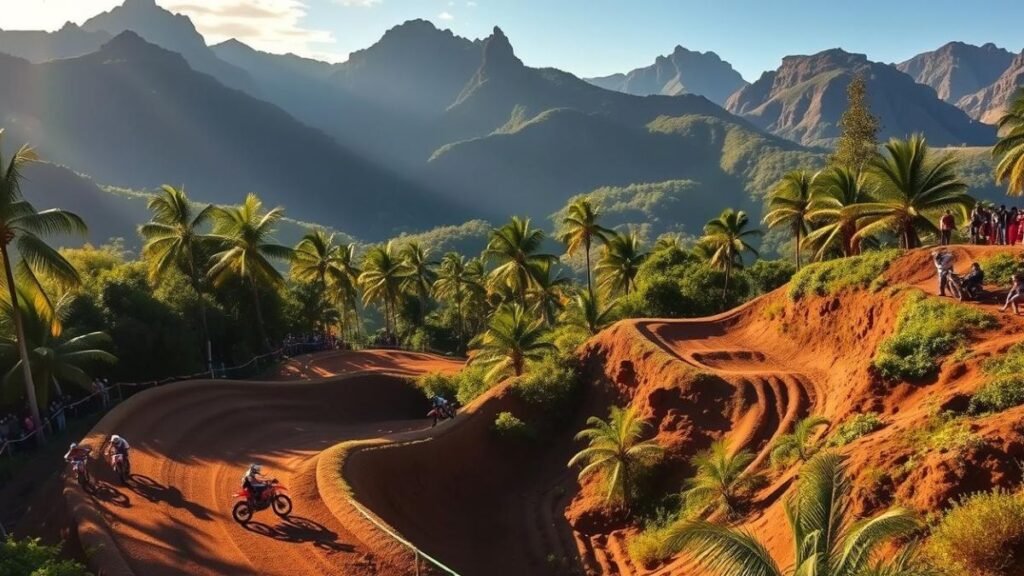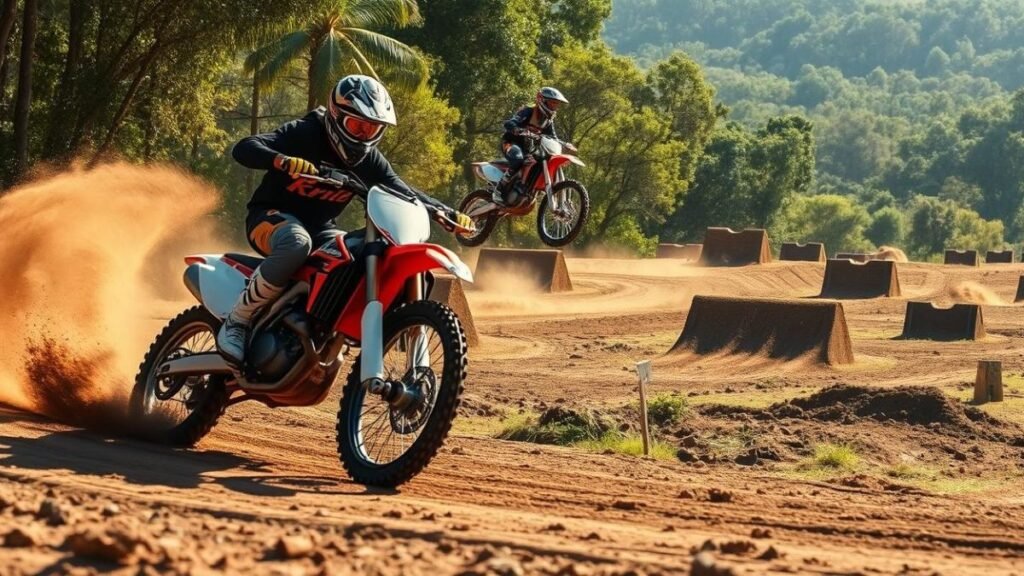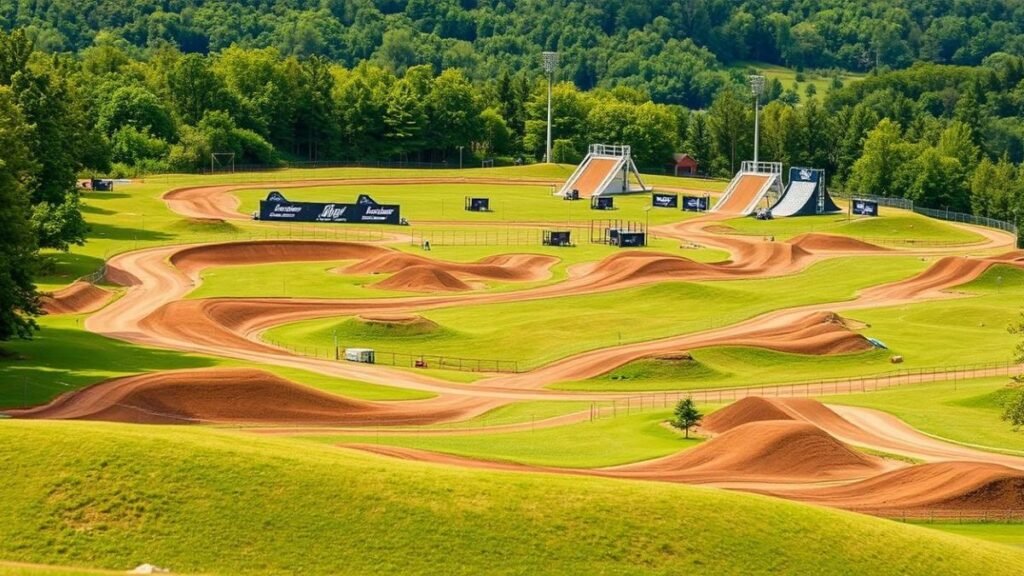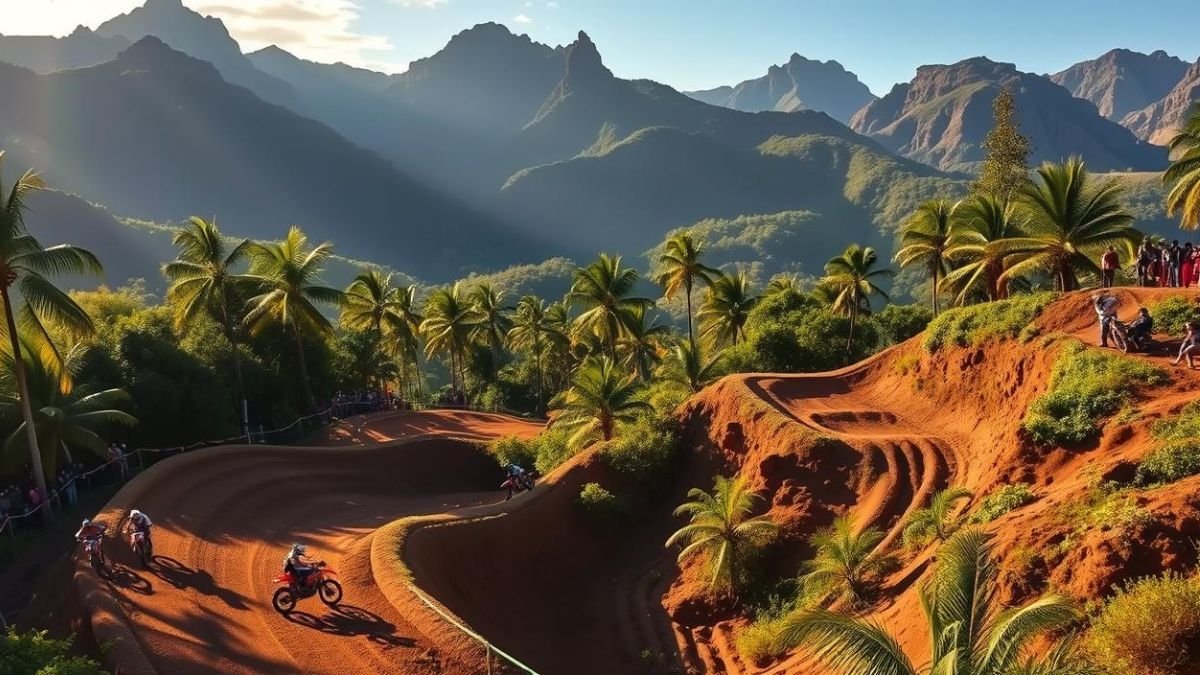Introduction
What makes Brazil’s off-road tracks stand out in a world dominated by legendary U.S. circuits? The answer lies in its breathtaking landscapes and relentless technical demands that challenge even the most skilled riders in motocross racing.
From the lush green hills to the arid stretches of sandy terrain, Brazil offers a diverse array of environments that not only enhance the riding experience but also test the limits of speed and agility. Brazil has quickly become a hotspot for riders seeking adrenaline-fueled challenges, as they navigate intricate courses that require not just raw power but also finesse and strategic thinking.

The country’s tracks blend natural terrain with man-made obstacles, creating a unique experience that is both exhilarating and demanding. Unlike the well-known Fox Raceway or High Point Raceway, Brazilian courses are designed to test not only speed but also adaptability, pushing riders to their physical and mental limits.
Recent events, such as Chance Hymas’ dominant 1-1 finish at Thunder Valley, demonstrate Brazil’s growing influence on the global motocross stage, showcasing how its tracks can challenge even the most seasoned riders.
From deep sand stretches that require precise throttle control to steep hills that test a rider’s strength and technique, these five tracks redefine what it means to ride. Each offers a distinct mix of speed, skill, and strategy, where the unpredictable nature of the terrain keeps competitors on their toes. Whether you’re a seasoned competitor or an adventurous enthusiast, Brazil’s courses deliver unforgettable moments filled with adrenaline and excitement, making every race a true test of endurance and mental fortitude.
Key Takeaways
- Brazil’s tracks combine natural landscapes with technical challenges.
- The terrain varies from deep sand to steep, rugged hills.
- Courses test both speed and adaptability for riders.
- Recent race results have highlighted Brazil’s growing influence in the sport.
- Five must-visit tracks offer unique experiences for every skill level.
Introduction to Motocross Racing
Few sports demand the raw skill and endurance required by high-speed off-road competition. Governed by the FIM, this discipline blends 30-minute sprints with technical laps, testing riders across 250cc and 450cc classes.
The evolution from 2-stroke to 4-stroke engines has only amplified the intensity, introducing a new level of performance and strategy that riders must master. Each engine type offers distinct characteristics, influencing how competitors approach the track, manage their speed, and navigate the varied terrain.
The shift to 4-stroke engines has not only changed the dynamics of power delivery but has also made races more competitive, as riders must adapt their techniques to harness the unique capabilities of these machines.
What Makes Motocross Unique?
Unlike traditional circuits, tracks combine natural obstacles with man-made jumps, creating a challenging environment that tests a rider’s versatility and skill. Brazil’s rainforest courses, for example, feature soft, rutted surfaces after tropical rains, which can significantly affect traction and control.
These conditions require riders to continually adapt their techniques, as the changing terrain creates unpredictable challenges that must be navigated with precision. Jason Thomas notes, “Riders must master late braking and weight distribution to avoid washouts,” highlighting the importance of technique in such dynamic conditions. Proper body positioning and the ability to read the track are crucial for maintaining speed and stability.
Compare this to California’s Prairie City SVRA, where hardpack terrain rewards aggressive throttle control and precise cornering. The 2024 FIM updates now mandate stricter track safety, including padded barriers and graded landings, which aim to protect riders from the increasing speeds and risks associated with modern motocross racing. These changes not only enhance safety but also encourage riders to push their limits while navigating the courses, knowing that the tracks are designed with their well-being in mind.
Why Brazil’s Tracks Stand Out
Elevation changes here rival Colorado’s Thunder Valley (5,860’ altitude), but humidity adds another layer of complexity that riders must navigate. The unique combination of high altitudes and moisture creates a challenging environment where steep climbs demand peak horsepower and optimal performance from both the motorcycle and the rider.
Moreover, sudden downpours can transform what was once a firm dirt surface into slippery challenges, requiring quick reflexes and advanced riding techniques to maintain control. It’s a proving ground for both man and machine, testing endurance, skill, and adaptability in unpredictable conditions.
“Brazil’s diversity forces adaptability—you can’t just rely on speed.”
—Professional rider analysis
The Thrilling History of Motocross
The roar of engines and flying dirt tells the story of a sport born from British ingenuity. What began as “scrambles” in 1924, Camberley evolved into a global phenomenon, blending speed, skill, and engineering breakthroughs.
Over the decades, motocross has not only captivated audiences with its thrilling races but has also fostered a unique culture, inspiring countless enthusiasts and aspiring riders. The early days saw riders pushing the limits of their machines, experimenting with modifications that would later become industry standards.
This spirit of innovation laid the groundwork for the sophisticated technology we see today, where precision engineering and performance optimization are paramount in competitive racing.
From British Scrambles to Global Phenomenon
Torsten Hallman’s 1966 U.S. exhibition proved that 2-stroke motorcycles could outperform heavier models, showcasing not only their speed but also their agility on various terrains.
His remarkable dominance during this period shifted industry focus towards these lighter machines, prompting manufacturers to rethink their designs and strategies. This pivotal moment in motocross history paved the way for Yamaha’s groundbreaking 1997 YZM400 prototype, which refined lightweight designs and set new standards for performance and handling in competitive racing.
Key rule changes followed in the wake of these innovations. The AMA’s 1997 decision to allow 550cc 4-stroke motorcycles opened the floodgates for riders to harness raw power and enhance their competitive edge.
Brazil mirrored this with local motorcycle modifications, adapting to varied terrain and creating unique challenges that tested riders’ skills and ingenuity. These adaptations not only improved performance but also fostered a culture of creativity and resourcefulness among Brazilian motocross enthusiasts.
Brazil’s Role in Motocross Evolution
In the 1980s, Brazil invested significantly in motocross infrastructure, creating tracks that not only tested engine displacement limits but also pushed the boundaries of rider skill and endurance. These tracks became vital arenas for developing local talent, as they incorporated challenging features such as steep inclines, sharp turns, and unpredictable terrain. Jeffrey Herlings’ 2025 Latvian MXGP win highlighted the Europe-Brazil rivalry, fueled by technical innovation and the increasing competitiveness of Brazilian riders who had honed their skills on these demanding circuits.
“Brazil’s tracks forced riders to rethink throttle control—wet clay demanded precision, not just speed, requiring them to adapt their techniques and strategies to navigate the unique conditions effectively.”
—Mechanic, 2019 São Paulo GP
| Year | Event | Impact |
|---|---|---|
| 1924 | First scramble (UK) | Launched off-road racing |
| 1966 | Hallman’s U.S. tour | Popularized 2-stroke motorcycles |
| 2008 | Brazil’s first FIM event | Marked South America’s rise |
Today, Brazil’s FIM-sanctioned championship events draw crowds rivaling Washougal’s historic 1971 races. The sport’s growth reflects a world where adaptability trumps tradition.
Top 5 Motocross Tracks in Brazil
Five Brazilian circuits stand out for their unique blend of natural and man-made obstacles, creating a diverse racing experience that is both thrilling and demanding. Each track presents distinct challenges, ranging from the corrosive effects of coastal salt spray on machinery to the intense jungle humidity that tests riders’ endurance and focus.
Riders often compare these Brazilian tracks to iconic U.S. venues, such as Ironman Raceway, but the unique topography and environmental conditions of Brazil’s terrain demand sharper adaptability and a more versatile skill set. The varied landscapes require riders not only to master their motorcycles but also to develop a keen sense of strategy, adjusting their techniques on the fly to navigate the unpredictable elements they face on race day.
1. Pista de Motocross do Rio de Janeiro
Coastal winds and salt-air corrosion test motorcycles here, similar to Budds Creek’s clay but with added wear. The relentless salt spray not only affects the motorcycle’s frame but also seeps into sensitive components, leading to potential mechanical failures if not meticulously maintained.
Deep ruts form after rains, forcing riders to adjust suspension setups and tire pressures to cope with the shifting terrain. Local events often see unexpected results due to shifting conditions, as the unpredictable weather can dramatically alter track conditions overnight, making it crucial for riders to adapt quickly and effectively.
2. Campo Grande, MX Park
This 1.2-mile circuit mirrors RedBud MX’s 110’ uphill climb but adds tight corners that challenge even the most skilled riders. The elevation change strains engines, especially in 450cc classes, as they must work harder to maintain speed on the steep inclines.
Riders praise its technical sections, which reward precise throttle control and demand exceptional body positioning to navigate the sharp turns effectively, ensuring they maintain momentum while avoiding costly mistakes.
Additionally, the varying surfaces, ranging from hard-packed dirt to loose gravel, require riders to continually adapt their riding style, making each lap a test of skill and strategy. The atmosphere during race days is electric, with fans cheering as competitors tackle the demanding layout, creating a vibrant community spirit that adds to the overall excitement of the event..
3. São Paulo Supercross Arena
A covered stadium hosts nighttime races, such as the LA Coliseum. The compact layout favors aggressive starts and rhythm sections. Floodlights create dramatic shadows, adding visual challenges for competitors. The sound of revving engines echoes throughout the arena, intensifying the thrill for both riders and spectators. As the night progresses, the atmosphere becomes even more charged, with fans waving flags and chanting for their favorite racers, turning the event into a celebration of motocross culture and competition.
4. Amazonia Dirt Challenge Track
Jungle terrain requires motorcycle modifications—KTM and Husqvarna enduro models dominate here. These motorcycles are specifically designed to handle the unique challenges presented by the environment, which includes not only dense foliage but also uneven ground and hidden obstacles. Soft soil and sudden downpours make traction unpredictable, creating a testing ground for both rider skill and machine performance. “It’s like riding on wet marbles,” describes a local competitor, emphasizing the difficulty of maintaining control in such conditions. The riders must adapt quickly, often adjusting their techniques mid-race to cope with the slippery surfaces and the varying terrain.
5. Brasília National Motocross Circuit
This government-built FIM Grade A facility seats 15,000 spectators, providing an impressive venue for both competitors and fans. Wide lanes allow high-speed passes, encouraging overtaking and thrilling maneuvers, but hardpack sections demand durable tires and expert handling.
The circuit design incorporates a variety of jumps and turns that challenge even the most seasoned racers. Major events here often decide championship results, making it a crucial stop on the motocross calendar. Riders often speak of the adrenaline rush that comes from competing on this track, where every lap can change the standings dramatically.
- Rio: Coastal corrosion vs. Maryland clay.
- Campo Grande: Elevation rivaling RedBud.
- São Paulo: Stadium-style night races.
- Amazonia: Jungle-ready motorcycle setups.
- Brasília: FIM-standard spectator capacity.
Essential Gear for Motocross Racing
Brazil’s demanding terrain requires gear that strikes a balance between protection and agility. Riders face everything from jagged rocks to deep mud, making equipment choices critical. The right setup enhances control while minimizing the risk of injury. This is particularly important in Brazil, where the combination of unpredictable weather and varied landscapes can create hazardous conditions, emphasizing the need for reliable and high-quality gear.
Protective Equipment Every Rider Needs
AMA mandates Snell M2020-certified helmets, but Brazil adds stricter rules to ensure maximum safety for competitors. CE-certified chest protectors and knee braces are non-negotiable for local events, as they provide essential protection against impacts and abrasions.
Riders must invest in gear that not only meets these standards but also offers comfort and durability during long races. Alpinestars Tech 10 boots provide superior ankle support, while Fox Racing’s Instinct line prioritizes lightweight flexibility, enabling quick movements and adjustments on the motorcycle.
Austin Forkner’s Kawasaki KX250 setup at Thunder Valley highlights pro standards, showcasing how top-tier riders equip themselves for success. His Leatt neck brace and 100% goggles combo defend against crashes and debris, which are common in the sport.
The goggles provide clear vision in muddy conditions, while the neck brace helps prevent serious injuries in the event of a fall. “Washouts happen fast here—gear saves you when skill can’t,” notes a São Paulo competitor, emphasizing the critical nature of having reliable equipment that can withstand the rigors of the track.
Choosing the Right Motorcycle for Beginners
New riders should start with forgiving machines like the Honda CRF250F, which is designed specifically to help novices build confidence and skill. Its 227cc air-cooled engine suits the 250cc class, meeting the 212lb weight minimum.
This lightweight design enables easier handling and maneuverability, making it less intimidating for beginners. Compare this to the race-ready CRF250R models, which require advanced throttle control and are better suited for experienced riders who can effectively manage their power.
Maintenance costs reveal another divide that new riders should be aware of. A 4-stroke motorcycle averages $1,200 per year, which includes regular oil changes, filter replacements, and other routine maintenance. In contrast, 2-strokes require rebuilds every 50-80 hours, which can add up quickly in terms of both time and expense.
Machines built for Brazil’s tracks often feature upgraded air filters and suspension to handle humidity and ruts, making them more resilient in challenging conditions. Understanding these differences is crucial for beginners as they select their first motorcycle and plan for the long-term investment involved in motocross riding.
“Brazil teaches you the hard way—if your gear fails, the track wins.”
—Local rider, Campo Grande MX Park
Understanding Motocross Racing Classes
Engine size plays a pivotal role in determining speed, control, and race strategy. Brazil’s tracks demand tailored setups, whether riders opt for nimble 250cc or powerhouse 450cc machines. The choice impacts everything from lap times to championship standings, as each class offers distinct advantages that can significantly affect a rider’s performance on the track. For instance, the lighter weight of the 250cc motorcycles enables quicker maneuverability, which is essential for navigating tight corners and technical sections of the track. Conversely, the 450cc machines provide superior acceleration and power, making them formidable on longer straightaways where speed is crucial.
250cc vs. 450cc: Which to Start With?
The 250 class is ideal for beginners, offering a balance of agility and manageable power. Honda’s CRF250R dominates here, with lap times averaging 2:15 at the Brasília Circuit, showcasing its reliability and performance. Compare this to the 450 class, where pros like Jett Lawrence utilize raw horsepower to achieve impressive 2:02 laps, highlighting the difference in capabilities between the two classes. The decision on which class to enter can be influenced by a rider’s experience level, physical strength, and personal preference, as each offers unique challenges and rewards.
Brazil’s Copa Turbo 300cc modified class bridges the gap between the two worlds, allowing AMA fuel rules while accommodating extra displacement, thereby creating a competitive environment that attracts a diverse range of riders.
This class serves as a bridge for those transitioning from 250cc to 450cc, providing an opportunity to experience the benefits of increased power without fully committing to the heavier machines. Haiden Deegan’s 250cc dominance proves lighter machines excel in technical sections, where precision and handling are paramount. At the same time, 450cc riders thrive on straightaways, where their motorcycle power can be fully utilized to gain an edge over competitors.
This dynamic between the classes adds an exciting layer to the racing experience, encouraging riders to continuously improve their skills and adapt their strategies based on the characteristics of their chosen machine.
Brazil’s Local and National Championships
From the Minas Gerais State Cup to the BRMX National series, Brazil’s championship circuit rivals global standards, showcasing the nation’s commitment to fostering competitive motocross talent. The FIM homologation process ensures that tracks not only meet safety and technical benchmarks for international events but also promote a level playing field for all competitors, allowing riders to push their limits in a secure environment. This rigorous standardization reflects Brazil’s ambition to elevate its motocross scene to a global audience, attracting both international riders and spectators.
“The Amazonas Challenge separates riders who adapt from those who just throttle hard. It’s about finesse and strategy as much as speed.”
—BRMX race director
- AMA 250MX: 150- 250cc limits vs. Brazil’s flexible 300cc modifications, allowing local riders to customize their machines for better performance on diverse terrains.
- FIM Rules: Padded barriers and graded landings are mandatory for all events, ensuring rider safety while maintaining competitive integrity.
- Spectator Impact: Crowds of 15,000+ at Brasília influence rider strategies, as the energy from the audience can motivate competitors to push beyond their limits.
Training Tips for Beginner Riders
New riders often underestimate the physical demands of competitive off-road events, which require not only skill but also significant physical conditioning. These events test not just the riders’ technical abilities but also their overall fitness levels, as the sport can be incredibly taxing on the body.
Pro athletes average 15 hours weekly training, with heart rates hitting 180 BPM during intense sessions, illustrating the rigorous nature of the sport. This level of training is essential, as riders must build not only strength but also agility and endurance to navigate challenging terrains.
To excel, focus on mastering techniques and building endurance tailored to Brazil’s rugged tracks, which present unique challenges that differ from those in other regions. The varied landscapes, including steep climbs and loose soil, demand a versatile skill set and the ability to adapt quickly to changing conditions.

Mastering Basic Techniques
Cornering drills used by Team Honda HRC at Fox Raceway sharpen control. These drills are crucial for developing the muscle memory needed to navigate tight turns effectively. Practice leaning into turns while maintaining throttle consistency, as this balance is vital for maximizing speed and stability.
For Brazil’s laterite soil, which can be quite challenging, learn the brake sliding technique—apply rear brakes to pivot smoothly without losing speed. This technique not only enhances cornering efficiency but also helps in maintaining traction on slippery surfaces, allowing riders to execute turns with precision and confidence.
Eli Tomac’s Colorado elevation regimen proves altitude adaptation matters. Training at high altitudes can significantly improve your lung capacity and overall endurance. Train at 70–85% of your maximum heart rate to mimic high-intensity races.
This way, you condition your body to cope with the reduced oxygen levels, which is particularly beneficial for races held in elevated regions. This preparation is essential, as it prepares your body for oxygen-thin conditions like those found in climbs like Campo Grande’s, where the ability to sustain high performance becomes critical.
Building Endurance and Control
Follow a 6-week conditioning plan simulating Thunder Valley’s 35-minute moto duration. This structured regimen is designed to build both strength and endurance, crucial for competitive performance. Mix sprint intervals with long rides to boost stamina, allowing your body to adapt to varying intensities.
Incorporating both short bursts of speed and longer, sustained efforts can enhance your overall fitness and prepare you for the demands of racing. “Recovery days are as critical as training days,” advises a São Paulo coach, emphasizing the importance of allowing your body time to heal and rebuild. Adequate recovery helps prevent injuries and ensures that you can perform at your best during training and races.
- Time your laps to track progress. This will help you identify areas for improvement and those that require additional focus.
- Use resistance bands to strengthen grip for technical sections. This added strength can improve your control over the motorcycle, especially in challenging terrains.
- Study local rider lines to optimize your way through ruts. Understanding the best lines can save precious seconds on the track and enhance your overall racing strategy.
“Brazil’s tracks reward those who train smart, not just hard.”
—BRMX Championship Trainer
The Global Appeal of Motocross Racing
Global interest in off-road events continues to grow, fueled by unique regional characteristics. Brazil’s tracks, for example, demand adaptability unseen in U.S. circuits like Ironman Raceway. The variety of terrains, from sandy stretches to rocky paths, challenges riders to constantly adjust their techniques and strategies.
Tropical rains create deep ruts that can shift dramatically during a race, while high altitude tests endurance. These factors reshape championship strategies, requiring riders to develop specialized skills for navigating them effectively.
How Brazil Compares to U.S. Tracks
Lap times reveal stark contrasts. Amazonia’s jungle terrain adds +8 seconds compared to Millville’s Spring Creek. The lush vegetation and unpredictable ground conditions in Brazil create a more complex racing environment. “Brazil’s laterite soil forces riders to brake earlier,” notes a 2024 MXGP analyst. This braking strategy is crucial, as it allows riders to maintain control on slippery surfaces. Meanwhile, Ironman’s November mud races prioritize raw power over technical finesse, where the ability to accelerate quickly out of corners becomes a key advantage for competitors.
Key differences:
- Brazil: Humidity and elevation strain engines (450cc dominance).
- U.S.: Hardpack surfaces reward aggressive throttle control.
Iconic International Events to Watch
The 2024 MXGP calendar features 20 rounds, including Brazil’s Rally dos Sertões. This endurance event rivals Austria’s Erzbergrodeo, featuring 500 km of unforgiving terrain. In 2025, Rio hosts South America’s first FIM Premier Class championship, expected to draw 90M viewers—close to MXoN’s world record.
“The sport’s growth hinges on showcasing diverse challenges.”
—BRMX Broadcast Director
TV coverage underscores this shift. While AMA Pro races average 1.2M viewers, Brazil’s BRMX finals gain traction with dynamic track designs. The world is taking notice.
Safety Measures on the Track
From runoff areas to medical response, safety innovations redefine track standards. The FIM now mandates 10-meter buffer zones and padded barriers, while Brazil’s national events deploy helicopters for rapid evacuations. These changes reflect a sport where body protection is as important as speed.

Track Design and Rider Protection
São Paulo Arena’s energy-absorbing berms contrast sharply with Unadilla’s natural terrain. The Brazilian venue utilizes geotextile layers to mitigate impacts, resulting in a 40% reduction in crash forces. Key differences:
- Runoff space: 12m in Brazil vs. 8m at U.S. tracks.
- Surface grading: Daily maintenance prevents ruts from forming during the race.
- Time-saving designs: Wider lanes allow safer overtakes.
Common Injuries and How to Avoid Them
Collarbone fractures (18%) and ACL tears (12%) top injury lists. Concussions dropped to 9% after the 2024 14-day rest rule. Garrett Marchbanks’ 2023 tibial plateau fracture comeback highlights rehab advances.
“Neck braces cut spinal injuries by 60%—there’s no way I’d ride without one.”
—Pro rider, Leatt user
Prevention tips:
- Leatt braces reduce neck torque by 43% vs. Atlas’ 37%.
- Train core strength to stabilize your body in crashes.
- Schedule time for gear checks before every session.
How to Get Started in Motocross
Brazil’s vibrant riding culture welcomes newcomers with open trails, fostering a sense of community and adventure. Whether aiming for competitive events or weekend adventures, the right approach ensures success. Focus on three pillars: local tracks, essential gear, and race-day readiness. Engaging with experienced riders and participating in local events can greatly enhance your skills and confidence, providing invaluable insights into the sport.
Finding Local Tracks and Communities
Brazil offers 22 public practice tracks and 58 private facilities, catering to riders of all skill levels. Public options, such as Goiânia MX Park, provide affordable access, while private clubs offer coaching and structured training programs that can help accelerate your learning curve. The BRMX website lists approved venues with safety ratings, ensuring that newcomers can find safe and suitable locations to practice their skills.
| Track Type | Avg. Cost/Day | Best For |
|---|---|---|
| Public | $20–$50 | Casual practice |
| Private | $80–$150 | Structured training |
Join Facebook groups like “Rio Riders Collective” to connect with mentors and fellow enthusiasts who share your passion for motocross. These communities often organize group rides and events, which can be a great way to meet other riders and learn from their experiences. Additionally, AMA’s $50 annual membership includes U.S. track discounts—useful for travelers looking to explore new tracks across the country.
First-Time Race Day Checklist
BRMX Novice Class mandates 30 logged practice hours and a medical certificate. Follow this pre-race routine:
- Gear: Budget $2,500–$4,500 for a helmet, boots, and armor (comparisons between Alpinestars and Fox can be helpful).
- Motorcycle checks: Measure sag (100–110mm rear) and clean air filters—critical for Brazil’s dust.
- Hydration: Jorge Prado’s Thunder Valley strategy: 20oz water per hour + electrolytes.
“Arrive early to walk the track—every rut changes your way of attacking it.”
—Jorge Prado, Red Bull KTM
FIM “C” licenses cost $120 and require a written safety test. Allocate time for gear checks and warm-up laps before events. Most crashes happen in the first 10 minutes. Learn more about Motorcycle Tour.
Easter Eggs
Conclusion
Brazil has transformed into Latin America’s premier destination for off-road competition since 2015. Its tracks blend natural challenges with world-class design, drawing riders from across the globe.
Plan your visit between June and August for ideal conditions. The dry season offers predictable terrain, letting you focus on technique. Tourism for this sport has surged 40% since 2022, proving its growing appeal.
Always prioritize safety—follow FIM’s “Ride Smart” guidelines. Proper gear and track awareness save time and prevent injuries.
Don’t miss the 2025 Rio MXGP, with tickets available October 1st. It’s the perfect way to experience Brazil’s vibrant riding culture firsthand.
FAQ
What makes Brazilian tracks different from others?
Brazil’s tracks blend challenging terrain with unique natural elements, such as red dirt and elevation changes, offering riders a dynamic experience.
Which motorcycle is better for beginners, 250cc or 450cc?
A 250cc machine is ideal for new riders due to its lighter weight and easier handling, while a 450cc motorcycle suits advanced competitors with higher power demands.
What safety gear is essential for motocross?
Helmets, goggles, chest protectors, gloves, and knee braces are critical to minimize injury risks on rough terrain.
How do I find local events in Brazil?
Check regional federations, such as the Brazilian Motorcycle Confederation (CBM), for schedules, or join clubs near tracks like the São Paulo Supercross Arena.
What’s the best way to train for motocross?
Focus on core strength, balance drills, and practice sessions on varied tracks to build endurance and motorcycle control.
Are there international events held in Brazil?
Yes, Brazil hosts rounds of the FIM Motocross World Championship and national series, drawing top riders from around the world.




